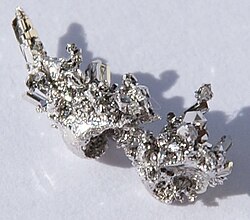Palladium
Over half of the supply of palladium and its congener platinum goes into catalytic converters, which convert up to 90% of harmful gases from auto exhaust (hydrocarbons, carbon monoxide, and nitrogen dioxide) into less-harmful substances (nitrogen, carbon dioxide and water vapor). Palladium is also used in electronics, dentistry, medicine, hydrogen purification, chemical applications, groundwater treatment and jewelry. Palladium plays a key role in the technology used for fuel cells, which combine hydrogen and oxygen to produce electricity, heat, and water.
Ore deposits of palladium and other PGMs are rare, and the most extensive deposits have been found in the norite belt of the Bushveld Igneous Complex covering the Transvaal Basin in South Africa, the Stillwater Complex in Montana, United States, the Thunder Bay District of Ontario, Canada, and the Norilsk Complex in Russia. Recycling is also a source of palladium, mostly from scrapped catalytic converters. The numerous applications and limited supply sources of palladium result in the metal attracting considerable investment interest.
Occurrence
In 2007, Russia was the top producer of palladium, with a 44% world share, followed by South Africa with 40%. Canada with 6% and the U.S. with 5% are the only other substantial producers of palladium.
Palladium can be found as a free metal alloyed with gold and other platinum-group metals in placer deposits of the Ural Mountains, Australia, Ethiopia, North and South America. For the production of palladium these deposits play only a minor role. The most important commercial sources are nickel-copper deposits found in the Sudbury Basin, Ontario, and the Norilsk–Talnakh deposits in Siberia. The other large deposit is the Merensky Reef platinum group metals deposit within the Bushveld Igneous Complex South Africa. The Stillwater igneous complex of Montana and the Roby zone ore body of the Lac igneous complex of Ontario are the two other sources of palladium in Canada and the United States. Palladium is found in the rare minerals cooperite and polarite.
Palladium is also produced in nuclear fission reactors and can be extracted from spent nuclear fuel (see synthesis of precious metals) though this source for palladium is not used. None of the existing nuclear reprocessing facilities are equipped to extract palladium from the high-level radioactive waste.
| Symbol | Pd | |
| Atomic Number | 46 | |
| Atomic Weight | 106.42 | |
| Oxidation States | +2,+3 | |
| Electronegativity, Pauling | 2.2 | |
| State at RT | Solid, Metal | |
| Melting Point, K | 1825 | |
| Boiling Point, K | 3413 |
Appearance and Characteristics
Harmful effects:
Palladium is considered to be of low toxicity.
Characteristics:
- Palladium is a rare, lustrous, silvery-white metal.
- It is one of the of the six platinum group metals consisting of platinum, palladium, rhodium, osmium, iridium and ruthenium.
- The Platinum Group Metals
- These metals have similar properties and are often present in the same mineral ores.
- Palladium is malleable and ductile and like gold, it can be beaten into thin leaf.
- It does not tarnish in air but does tarnish lightly in moist air containing sulfur.
- The metal is strongly resistant to corrosion in air and to the action of acids (except nitric acid) at ordinary temperatures.
- When present in compounds, palladium exists mostly in the oxidation state II.
- Palladium is remarkable in its capacity to absorb up to 900 times its own volume of hydrogen. As it absorbs the hydrogen, it expands visibly, like a sponge swelling up when absorbing water.
Uses of Palladium
- The largest use of palladium is in catalytic converters for automobiles.
- Finely divided palladium is used as a catalyst for hydrogenation/dehydrogenation reactions and for petroleum cracking.
- The metal is used in jewelry, for example in white gold (an alloy of gold decolorized by the addition of palladium).
- Palladium is used in dentistry, watch making, and in making surgical instruments and electrical contacts.
- It is also used to purify hydrogen because the gas easily diffuses through heated palladium.
